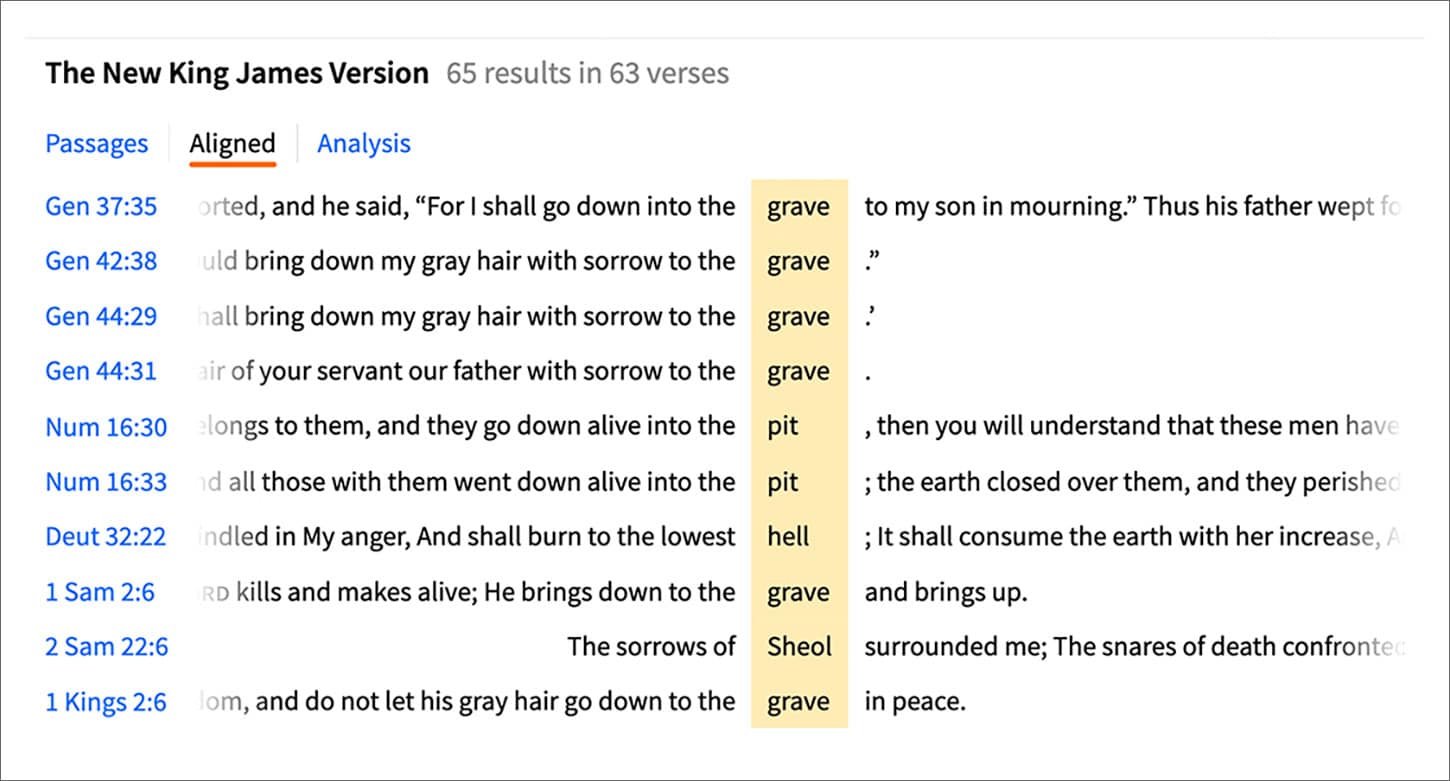Bible Question:
How accurate is the NKJV translation of Sheol in the O.T.?
Bible Answer:
How accurate is the NKJV translation of Sheol in Numbers 16:30, 33? This is an important question because it helps us determine the accuracy of the NKJV Bible. Since the English word Sheol comes from the Hebrew word seol, we will explore how the NKJV translated the Hebrew word seol in the Old Testament in other places. The reader will discover that the NKJV is inconsistent in its translation of seol. It translates the Hebrew word seol four different ways. What follows explains why the NKJV Bible is inconsistent. If you are looking for the most accurate Bible, read “Are any of the English Bible translations 100% accurate?”

The chart above is from the Logos Bible Software. It shows how the New King James Version (NKJV) Bible translates the Hebrew word seol beginning in Genesis through 1 Kings 2:6. The chart does not show all 65 times the Hebrew word seol appears in the Old Testament. The chart only gives a sample of how the NKJV translates the Hebrew word seol.
The NKJV translates this Hebrew word seol into four different English words in the Old Testament. For example, it translates seol as the grave (Genesis 37:35; 42:38; 44:29, 31; 1 Samuel 2:6, and many other places), pit (Numbers 16:30, 33), hell (Deuteronomy 32:22; Psalm 9:17; 55:15; 139:8; Proverbs 5:5; 7:27; 9:18; 15:11, 24; 23:14; 27:20; Isaiah 14:9; Ezekiel 31:15, 16, 17; 32:21, 27; Amos 9:2; Habakkuk 2:5), and Sheol (2 Samuel 22:6; Job 11:8; 17:16; 26:6; Psalm 16:10; 18:5; 86:13; 116:3; Proverbs 1:12; Isaiah 5:14; 14:11, 15; 28:15, 18; 38:10, 18; 57:9; Jonah 2:2).
That is, the NJKV translates seol as the grave twenty-five times, as the pit two times, as hell twenty times in the Old Testament, and as Sheol eighteen times. Most of the time it translates the Hebrew word for Sheol as the grave and hell (45 out of 65 times). This means the NKJV translates the Hebrew word seol as Sheol only 18 times out of the 65 times the word occurs in the Old Testament. Why is the NKJV inconsistent? Anyone who just read their Bible would not understand that the word for grave in Genesis 37:35, pit in Numbers 16:30, 33, hell in Deuteronomy 32:22, and Sheol in 2 Samuel 22:6, for example, all come from the same Hebrew word seol!
In contrast the ESV, LEB, LSB, HCSB, and NASB translate the Hebrew word seol as Sheol one hundred percent of the time. This demonstrates that the NKJV was inconsistent in its translations. When it translates seol so differently, it acts like a commentary since Sheol does refer to the grave. The publishers of the NKJV applied the policy of dynamic equivalence rather than formal equivalence. When the publishers gave the translation as “pit” two times, it was just inconsistent.
Conclusion
If you are looking for the most accurate Bible, read Are any of the English Bible translations 100% accurate? A more literal translation is best for Bible study – not a Bible that follows the policy of dynamic equivalence.
Suggested Links:
Are any of the English Bible translations 100% accurate?How to Study the Bible Step-by-Step.
Preparing To Know What The Bible Says — Best Bibles and More. bles and More
Is The King James Bible The Best Bible?
Does the Bible contain errors, discrepancies, contradictions or mistakes?
Should we use only the King James Version Bible? What is the best Bible?
How accurate is the New World Translation? – Jehovah’s Witnesses Bible